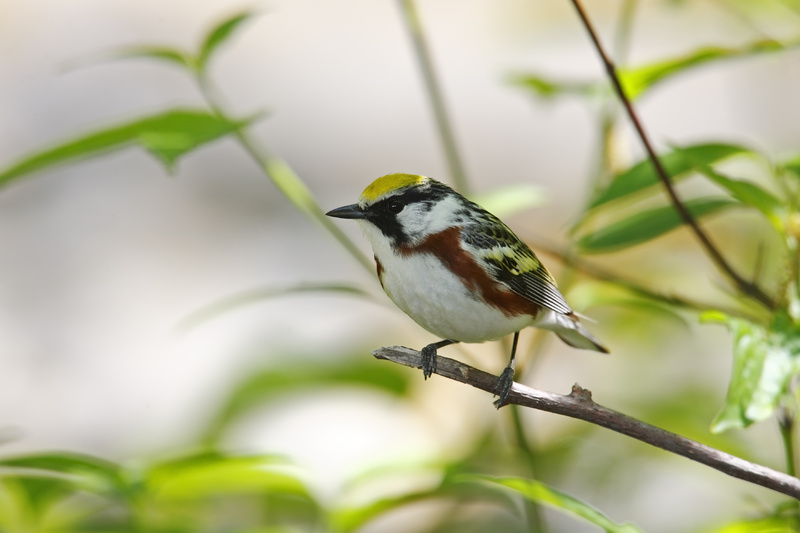The spring migration is peaking now. It sure is great to hear the woods and fields filled with song. The latest migrants we have are blackpoll warblers and black-billed cuckoos. Their imminent arrival signals the end of migration.
Today, I want to focus on a delightful and common migratory breeding bird, the chestnut-sided warbler. Males are colorfully marked with a yellow crown, white cheeks, a dark back with bold yellow streaks and two prominent yellow bars on each wing. The underside is white except for the broad chestnut stripe on the flanks that give the bird its common name.
The adult female is quite similar to the male with slightly more muted colors.
Chestnut-sided warblers are one of the most abundant warblers in our area. They prefer scrubby vegetation and the edges of woodlands. They have not always been so common. Two hundred years ago, naturalists hardly ever reported chestnut-sided warblers. Why? Because most of the eastern United States was old-growth forest then, providing unsuitable habitat for chestnut-sided warblers.
As humans cleared the forests to make space for agricultural fields, cow pastures, villages and towns, edge habitat was created. As a result, chestnut-sided warblers increased and continue to do well as humans alter more of the natural landscape. Chestnut-sided warblers are one of the few species that are positively affected by clear-cutting practices.
Chestnut-sided warblers are not particularly secretive birds but the dense habitat they prefer sometimes makes them difficult to see well. A little patience rewards the observer. The presence of chestnut-sided warblers is usually detected by their distinctive, loud songs.
Chestnut-sided warbler males sing two different songs. The more commonly heard song has been likened to the phrase “pleased pleased pleased to meetcha!” where the last phrase is sung explosively. This song is referred to as an accented-ending song. The male sings this song early in the nesting season, mostly before the females arrive on the breeding grounds. This accented-ending song is used to announce the possession of a breeding territory and is directed to the arriving females.
The second song, given later in the nesting season, is an unaccented-ending song. This song is somewhat reminiscent of a yellow warbler’s song and lacks the emphatic ending phrase of the accented-ending song. The unaccented-ending song is mostly directed at other male chestnut-sided warblers, essentially telling other males to stay out of its territory.
Chestnut-sided warblers are mainly birds of the northeast quadrant of North America, breeding from Nova Scotia west to Saskatchewan. The southern breeding distribution extends just south of the Great Lakes. Along the eastern seaboard, these birds nest widely as far south as Maryland and extend down into northeastern Georgia along the Appalachians.
Wintering areas for these birds are in Central America, with Costa Rica boasting the most wintering chestnut-sided warblers.
Nests are built entirely by the female, although the male will sometimes accompany the females as she constructs the nest. The nest is usually built in the crotch of a small tree, quite close to the ground. Average height above the grounds is only about 20 inches with some nests being a little more than a yard off the ground and some as low as six inches off the ground.
Most females will lay four eggs. Like nearly all other songbirds in North America, only female chestnut-sided warblers incubate the eggs. Hatching occurs after 11-12 days.
Both mom and dad feed the youngsters. It only takes the young warblers 11 days to be able to fly and leave the nest. After leaving the nest, the young warblers fly to thick, low vegetation and wait to be fed. The young birds will continue to beg for food from their parents for four weeks after leaving the nest.
Chestnut-sided warblers are susceptible to brood parasitism by brown-headed cowbirds. In the most thorough study of the effect of cowbirds on chestnut-sided warblers, conducted in Ontario, 20 percent of chestnut-sided warblers had at least one cowbird egg in the nest. The parents raise the chick as their own, never realizing they have been duped by the cowbirds.
Chestnut-sided warblers have a diet consisting almost exclusively of insects, mainly the caterpillars and the larvae of various species of flies.
On the breeding grounds, chestnut-sided warblers tend to forage near the ground, gleaning insects from the leaves of deciduous trees and shrubs.
These birds are particularly adept at searching on the undersides of leaves. If you spend a little time watching chestnut-sided warblers, you will be able to see this foraging method.
Herb Wilson teaches ornithology and other biology courses at Colby College. He welcomes reader comments and questions at: whwilson@colby.edu
Send questions/comments to the editors.



Success. Please wait for the page to reload. If the page does not reload within 5 seconds, please refresh the page.
Enter your email and password to access comments.
Hi, to comment on stories you must . This profile is in addition to your subscription and website login.
Already have a commenting profile? .
Invalid username/password.
Please check your email to confirm and complete your registration.
Only subscribers are eligible to post comments. Please subscribe or login first for digital access. Here’s why.
Use the form below to reset your password. When you've submitted your account email, we will send an email with a reset code.